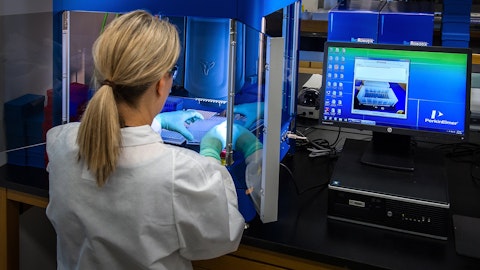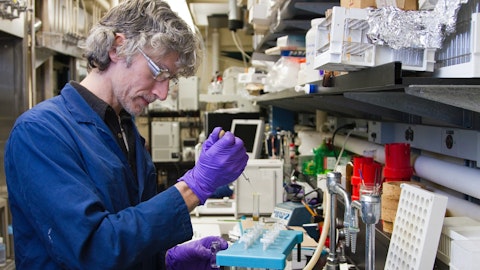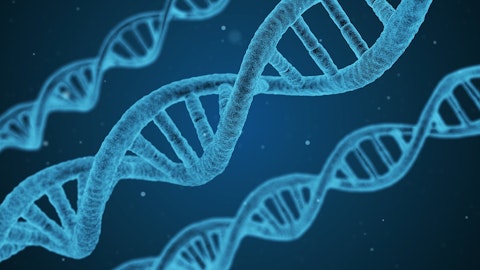Editas Medicine, Inc. (NASDAQ:EDIT) Q3 2023 Earnings Call Transcript November 3, 2023
Editas Medicine, Inc. beats earnings expectations. Reported EPS is $-0.00055, expectations were $-0.64.
Operator: Good morning, and welcome to Editas Medicine’s Third Quarter Conference Call. All participants are now in listen-only mode. There will be a question-and-answer session at the end of this call. Please be advised that this call is being recorded at the company’s request. I would now like to turn the call over to Cristi Barnett, Corporate Communications and Investor Relations at Editas Medicine.
Cristi Barnett: Thank you, Rob. Good morning, everyone, and welcome to our third quarter 2023 conference call. Earlier this morning, we issued a press release providing our financial results and recent corporate updates. A replay of today’s call will be available in the Investors section of our website approximately two hours after its completion. After our prepared remarks, we will open the call for Q&A. As a reminder, various remarks that we make during this call about the company’s future expectations, plans and prospects constitute forward-looking statements for the purposes of the Safe Harbor provisions under the Private Securities Litigation Reform Act of 1995. Actual results may differ materially from those indicated by these forward-looking statements as a result of various important factors, including those discussed in the Risk Factors section of our most recent Annual Report on Form 10-K, which is on file with the SEC as updated by our subsequent filings.
In addition, any forward-looking statements represent our views only as of today and should not be relied upon as representing our views as of any subsequent date. Except as required by law, we specifically disclaim any obligation to update or revise any forward-looking statements, even if our views change. Now, I will turn the call over to our CEO, Gilmore O’Neill.
Gilmore O’Neill: Thanks, Cristi, and good morning, everyone. Thank you for joining us today on Editas Medicine’s third quarter earnings call. I am joined today by four other members of the Editas executive team, Baisong Mei, our Chief Medical Officer; Erick Lucera, our Chief Financial Officer; Linda Burkly, our Chief Scientific Officer; and Caren Deardorf, our Chief Commercial and Strategy Officer. We are pleased with Editas’ momentum and progress in the third quarter, and I look forward to sharing these details. Before that however, let’s take a quick step back to provide perspective. Editas’ goal is to deliver life changing medicines to patients with previously untreatable or undertreated diseases. I joined Editas in June 2022 to help realize this goal, tasked with guiding the company’s evolution from a platform development company to a commercial therapeutics company.
As many of you know, in January of this year, we shared Editas decision and strategy to position Editas as a leader in programmable gene editing. As a reminder, three pillars underpin our strategy. First, to accelerate the clinical development of EDIT-301, our autologous ex vivo gene edited medicine for severe sickle cell disease and transfusion dependent beta thalassemia and drive it towards approval and launch. Second, to sharpen our discovery focus to in vivo editing therapies. And third, expand our business development activities to partner complementary technological capabilities that can advance our in vivo pipeline development in addition to out-licensing our robust IP and knowhow to maximize the use of CRISPR-based medicines. At the start of 2023, we outlined the following 2023 objectives.
For EDIT-301 to provide a clinical update from the EDIT-301 RUBY trial for severe sickle cell disease or SCD by the end of 2023. To provide a clinical data update from EDIT-301 EdiTHAL trial for transfusion dependent beta thalassemia or TDT by the end of 2023 and to have dosed 20 total patients in the RUBY trial by the end of 2023. For in vivo medicine development hire a new Chief Scientific officer with specific expertise aligned to our vision and to advance the discovery of in vivo editing of hematopoietic stem cells or HSEs and other tissues. And for business development to leverage our robust IP portfolio and business development capabilities to drive value and to complement our core gene editing technology capabilities. So how have we executed against this strategy and these objectives in the third quarter?
Let’s start with EDIT-301. First, on clinical data, we will present a company sponsored webinar in tandem with a poster presentation at ASH both on December 11 that is next month. We plan to share clinical data from 11 sickle cell patients in the RUBY trial and six beta thalassemia patients in the EdiTHAL trial. Baisong will share more details about our presentation later on the call. Second, on enrollment, we have enrolled 27 sickle cell and eight beta thalassemia patients into our RUBY and EdiTHAL studies, respectively, and screening continues at a good pace. Third, on dosing, we now expect to dose the 20th patient in the RUBY trial in the January 2024 timeframe due to individual patient schedules. And finally, for 2024 data disclosures, we remain on track to present a substantive clinical data set of sickle cell patients with considerable clinical follow-up in the RUBY study in the middle of 2024.
Baisong will share further details regarding our December data readout and clinical progress of EDIT-301 in his remarks. On the regulatory front, we are also pleased that just two weeks ago, the FDA recently granted us a Regenerative Medicine Advanced Therapy, or RMAT designation to EDIT-301 for the treatment of severe sickle cell disease. Advantages of the RMAT designation include all the benefits of the Fast Track and Breakthrough therapy designation programs, including, but not limited to, intensive FDA guidance on efficient and expedited drug development, possible rolling review, and priority review of the BLA. With respect to commercial plans, as we’ve previously shared, we made another important hire as we continued to gain momentum in pursuing a leadership position in hematopoietic stem cell medicines for hemoglobinopathies.
In late September, we announced that Caren Deardorf, a highly experienced and successful therapeutics commercial leader has joined Editas as our new Chief Commercial and Strategy Officer. Caren has a proven ability to translate early discovery and clinical assets into robust business strategies with disciplined portfolio prioritization and value creation. Additionally, she has led multiple successful U.S. and global product launches. Caren’s expertise and track record make her the ideal leader to help Editas reach this goal for patients. To further enable commercialization, as previously shared in July, we will increase our clean room capacity when we move our CMC team into the new AsierDevons facility in early 2024. With this increased capacity, we ensure our ability to scale EDIT-301 manufacturing both for clinical supply for our RUBY and EdiTHAL trials, as well as to prepare us for commercial readiness.
In a step forward for the gene editing industry and patients alike, we were delighted to see the recent exa-cel AdCom, the very focused review by FDA and the AdCom confirmed our confidence in the robust nature of our own off-target assessment. The patient testimonials in addition were incredibly moving and powerful and demonstrate the significant need for new and transformative medicines for the treatment of sickle cell disease. Turning now to in vivo and our pipeline development. As stated earlier this year, our drug discovery group began lead discovery work on in vivo therapeutic targets in hematopoietic stem cells and other tissues. And in July, we hired Linda Berkley as our Chief Scientific Officer to spearhead these efforts. Linda looks forward to sharing more at the appropriate time.
As a reminder, under our new target selection criteria, we will select therapeutic targets that will allow our genome editing approach to differentiate maximally from the current standard of care for serious diseases. The target selection criteria will work to identify targets that maximize the probability of technical, regulatory and commercial success. Now, let’s turn to business development. In August, we shared that we entered into an agreement with Vor Bio providing a non-exclusive license for ex vivo Cas9 gene edited HSC therapies for the treatment and/or prevention of hematological malignancies. Under this agreement, Editas received an upfront payment and will be eligible for future development, regulatory and commercial milestone payments as well as royalties on medicines utilizing the related intellectual property.
Turning to our intellectual property position. As a reminder, Editas holds a large portfolio of foundational U.S. and international patents and is the exclusive licensee of Harvard University and the Broad Institute’s Cas9 patent estate covering Cas9 use in developing human medicines. Only a small fraction of these patents are involved in the ongoing U.S. PTO interference proceedings. As the exclusive licensee, we are uniquely positioned to issue exclusive and non-exclusive sublicenses for Cas9 to any company seeking to use these enzymes to make human medicines, including in vivo and ex vivo uses. Our recently announced licensing deal with Vor Bio further bolsters our confidence that our IT portfolio provides meaningful value now and in future.

To conclude my remarks, we are energized by the promising efficacy and safety data we shared in June, signaling that EDIT-301 may be a clinically differentiated, one-time durable medicine that can provide life changing clinical benefits to patients with sickle cell disease and beta thalassemia in the-long term. Specifically driving early and robust correction of anemia and sustained increases in fetal hemoglobin. With our sharpened strategic focus, our world class scientists and employees, and our keen drive in execution, we continue to build momentum to progress our strategy to deliver differentiated editing medicines to patients with serious genetic diseases. I will now turn the call over to Baisong, our Chief Medical Officer.
Baisong Mei: Thank you, Gilmore. Good morning, everyone. Let’s start with EDIT-301 in development for severe sickle cell disease and transfusion dependent beta thalassemia. As Gilmore mentioned in his remarks, we continue to enroll and those patients in the RUBY trial for severe sickle cell disease and in the EdiTHAL trial for transfusion dependent beta thalassemia. As of today, in the RUBY trial, we have enrolled 27 patients and the 20 patients in the RUBY trial expected to be dosed in the January 2024 timeframe. In the EdiTHAL trial for transfusion dependent beta thalassemia, to-date, we have enrolled eight patients. As I shared earlier this year, I have been visiting and continue to visit our RUBY and EdiTHAL clinical trial sites, continuously speaking with our investigators and I appreciate the enthusiasm and the support of investigators and study sites.
I’m pleased with the momentum of EDIT-301 in patient recruitment, apheresis, editing and dosing in both studies. I’m excited to hear from the investigators that patients dosed with EDIT-301 have already seen positive changes in their lives. As we have previously shared, we will engage with FDA in the second half of the year. On a related note, we found the recent exa-cel AdCom insightful and this reaffirmed the power and potential of this gene editing technology. As a physician, I’m excited for patients living with serious diseases that gene editing has the potential to transform the treatment of the diseases and ultimately patient lives. As a drug developer, I’m eager to see the first medicine approved and swiftly followed by more medicine from other companies, including Editas.
More importantly, I’m excited to announce that we will share RUBY and EdiTHAL clinical data in a poster presentation at ASH, as well as in a company sponsored webinar both on Monday, December 11. So what we will show? The RUBY data set, we’re including clinical data from 11 patients. We will present efficacy data including total hemoglobin, fetal hemoglobin, and the vaso-occlusive events, or VOEs, and safety data including neutrophil and platelet engraftment. The follow-up period of these 11 patients includes two patients with at least 12-month follow-up and an additional four patients with at least a five-month follow-up. The other patients will have a one to four-month follow-up period. The EdiTHAL data set will include in simple data from six patients will present efficacy data including total hemoglobin and fetal hemoglobin and safety data including neutrophil and platelet engraftment.
The follow-up period after EdiTHAL treatment includes at least five months data from the first two patients treated. The other patient will have one to four months follow-up period. As a reminder, this past June, we shared promising RUBY clinical data in an oral presentation at the European Hematology Association Congress, or EHA, followed by our company sponsored webinar we also presented positive initial data from the first patient treating the EdiTHAL trial. The RUBY data set covers safety and efficacy data from the first four patients, including 10-month data from the first patient treated and six-month data from the second patient treated, including total hemoglobin and the fetal hemoglobin. Demonstrating EDIT-301 drives early robust correction of anemia to a normal physiological range of total hemoglobin in as early as four months after EDIT-301 treatment.
EDIT-301 drives robust sustained increase in fetal hemoglobin in excess of 40%. All four dose RUBY sickle cell patients remained free of vaso-occlusive events since EDIT-301 treatment. Additionally, all dose participants including four RUBY patients and one EdiTHAL patient showed successful engraftment within one month of dosing and has stopped the red blood cell transfusion. EDIT-301 was well-tolerated by patients and the safety profile of EDIT-301 was consistent with the myeloablative busulfan conditioning and autologous hemopoetic stem cell transplant. And the trajectory of collection of anemia and expression of fetal hemoglobin was consistent across EDIT-301 treated sickle cell patients and beta thalassemia patients at the same full of time points.
We continue to believe that EDIT-301 can potentially provide robust clinical benefit to patients with severe sickle cell disease and transfusion dependent beta thalassemia, potentially provide clinical differentiation in the long-term. We look forward to our presentation of additional clinical data and a longer follow-up in December. As we have previously stated, the choice of CRISPR enzyme and the target to edit it to switch on fetal hemoglobin expression matters, EDIT-301 is our proprietary AsCas12a enzyme to edit the HBG12 promoter. AsCas with 12a increases the efficiency of editing and significantly reduce off-target editing when compared to other CRISPR enzyme including Cas9. Editing HBG1 promoter — editing HBG12 promoter in human CD34 possible cells, resulting greater red blood cell production and normal proliferative capacity and improved red blood cell health when compared to editing of BCL11A.
We look at the differentiation in three categories of endpoints in clinical trials, hematological parameters and organ function, and the patient report outcome of quality of life. Based on the clinical data so far, we believe that sustained normal level of hemoglobin could be a potential point of differentiation for EDIT-301. As a reminder, a sustained normal total hemoglobin level is an important clinical outcome for patients and the correction of anemia can significantly improve quality of life and ameliorate the end organ damage. We look forward to sharing additional data, including RUBY and EdiTHAL clinical data next month. Now, I will turn the call over to Erick, our Chief Financial officer.
Erick Lucera: Thank you, Baisong, and good morning, everyone. I’m happy to be speaking with you today and with one quarter under my belt at Editas; I’m even more impressed by the quality of our science, our leadership in the gene editing field, the strong intellectual property portfolio, and our highly differentiated work from other players in the field. I was excited to join this summer and I continue to be impressed with what I see. With that, I’d like to refer you to our press release issued earlier today for a summary of our financial results for the third quarter 2023, and I’ll take this opportunity to briefly review a few items. Our cash, cash equivalents and marketable securities as of September 30 were $446 million compared to $480 million at June 30, 2023.
We expect our existing cash, cash equivalents and marketable equity securities to fund our operating expenses and capital expenditures into the third quarter of 2025. Revenue for the third quarter of 2023 was $5.3 million, which primarily relates to the upfront payment under the non-exclusive Cas9 license to Vor Bio in August 2023. R&D expenses this quarter were $41 million, essentially flat from the third quarter of 2022, which reflects various offsetting expenses, including decreases in R&D spend related to our reprioritization and targeted focus on our EDIT-301 program, offset by increased spending and pre-commercialization efforts, including medical affairs and patient advocacy. G&A expenses for the third quarter of 2023 were $15 million, which decreased from $16 million for the third quarter of 2022.
The decrease in expense is primarily attributable to decreased headcount expenses, including stock compensation and reduced legal costs. Overall, Editas remains in strong financial position bolstered by our sharpened discovery focused, June capital raise, recent out licensing deal. Our cash runway into the third quarter of 2025 provides ample resources to support our continued progress in the RUBY and EdiTHAL trials of EDIT-301, continue commercial manufacturing preparation, and advance our discovery and research efforts. As I’ve shared before, I’m a former buy-side investor and I know the value of buy-side and sell-side knowledge. I look forward to hearing from our shareholders as we work to advance our gene editing medicine. We value your feedback.
And with that, I’ll hand the call back to Gilmore.
Gilmore O’Neill: Thank you, Erick. As we continue our momentum and the execution our goals, it remains an exciting year for Editas. We look forward to continuing our transformation and sharing our progress with you. As always, it must be said that we could not achieve our objectives without the support of our patients, caregivers, investigators, employees, corporate partners and you, investment community. Thanks very much for your interest in Editas and we’re happy to answer questions. Thank you.
See also 30 Most Profitable Agricultural Business Ideas for Young Entrepreneurs and 25 Least Racist States in the US.
Q&A Session
Follow Editas Medicine Inc.
Follow Editas Medicine Inc.
Operator: Thank you. We’ll now be conducting a question-and-answer session. [Operator Instructions]. Thank you. Our first question comes from the line of Brian Cheng with J.P. Morgan. Please proceed with your question.
Brian Cheng: Good morning, guys. Congrats on the progress and thanks for taking my questions. [Technical Difficulty] develop off-target stack [ph] and services that you’re seeing. Can you give us a workout — can you give us a sense of the work that you’re doing for off-target. Are you doing whole genome sequencing and any other insights that you see as potential to your path to approval? Thank you.
Gilmore O’Neill: Brian thanks very much. I’m afraid it was incredibly difficult to hear you with the background noise and I know you’re suffering from some connection problems there. I think I heard you talk about off-targeting, so I’m assuming you’re referring to this week’s transform. Yes. And so let me just go with that and then we can follow-up if it’s incorrect. But, as you know, I think you referred to the AdCom, and I have to say is that the AdCom represented an incredibly and did a great excitement for this week. It was a great day for sickle cell warriors where patients now can think about not battling a disease, but actually living a life. It was a significant milestone for CRISPR genome editing as that AdCom represents sort of almost a penultimate step towards approval for the first CRISPR-based medicine.
What struck us in the very focused discussion of the AdCom was the positive tone, but actually also as we listened to the commentary, it really substantially strengthened our confidence in the very robust data package that we’ve generated about off-target editing. I hope I’ve answered your question, because with off-target editing is what I heard. I think the only other thing I want to emphasize, of course, is that we have chosen to advance our proprietary owned AsCas12a enzyme, which indeed has higher fidelity, and it’s a significant reduction in off-target edits when compared to Cas9.
Brian Cheng: Thanks, Gilmore. I guess my — I don’t know if you can hear me better now.
Gilmore O’Neill: Yes, that’s better. That’s better.
Brian Cheng: Okay. Okay. Yes. So I’m just wondering if there were a lot of focus specifically on off-target effects. So I’m just wondering if there is any work that you’re doing now that is different than the gene editors, players that are in the market that are different to make sure that the regulators will be happy with the way that you’re monitoring these off-target effects. Thank you so much.
Gilmore O’Neill: Yes. Thanks, Brian. I mean, without going into details, I don’t think its appropriate time to go into details. We are doing more than was discussed at the AdCom, and that’s where our confidence about the robustness of our data package comes from. I hope my — I hope that was the question.
Brian Cheng: Yes. That was very helpful. Thanks so much.
Gilmore O’Neill: Thanks very much, Brian. It sounds like you’re on a plane, so have a good trip.
Brian Cheng: Okay.
Operator: Our next question comes from the line of Samantha Semenkow with Citi. Please proceed with your question.
Samantha Semenkow: Hi, good morning. Thank you for taking my question. Yes, just to follow-up on the last question, Gilmore, and you sort of touched on this, the difference between Cas12a and Cas9. Can you just talk a little bit more in detail about what you’re seeing as the different off-target risk and how you’d be able to show that to regulators when you get to that stuff?
Gilmore O’Neill: Indeed. Happy to. Let me just preface again with the sort of high level that in published data we have and others have shown a substantial reduction in off-target editing when comparing AsCas12a versus the Cas9 enzyme. With regard to the data package that we have generated and continue to generate off-target, it is substantial. I’m not sure that we are in a place to share more details. I don’t know, Linda, if you have anything to add.
Linda Burkly: Yes, I would just — this is Linda Burkly, CSO. Yes, I would just add and echo what Gilmore just said that we’re using multiple orthogonal methods, additional method as compare — additional methods as compared to what we heard at the outcome. And so we’re very confident in our package as we proceed in our path to the BLA and yes, we — in our preclinical data, we are not seeing off-target editing in our pre-clinical experiments. So we’re very confident in our package going forward.
Operator: The next question is from the line of Joon Lee with Truist Securities. Please proceed with your question.
Joon Lee: Hey, thanks for the updates and for taking our questions. Based on all that’s been presented during the AdCom, where do you see room for clinical differentiation and is that something that we can expect to see at ASH? Specifically, can you comment on your platelet engraftment reticulocyte count and markers of hemolysis? Thank you.
Gilmore O’Neill: So I think the key thing is that we are very excited already by the clinical data that we have presented and what we see as a competitive fast follower with potential for differentiation. And what we’ve seen to-date was a consistent highest level correction of anemia to the normal physiological range, which is by design, choosing ASCs 12a to edit a gamma globin promoter. I’m going to ask Baisong to tell you a little more about what we can, about what we’re going to share at ASH on December 11.
Baisong Mei: Yes. Thanks, Gilmore. Thanks for the question, Joon. As I mentioned that in the ASH presentation, we’ll have data from 11 RUBY patients and six EdiTHAL patients and we will have longer follow-up period with two patients in the RUBY trial with at least 12 months. And then we have additional data from five months for the RUBY trial. And go back to your question also on these AdCom in there. And we are very actually pleased to see, as Gilmore mentioned, the very successful outcome. And we are from; I believe the technology and also the MOA of using hemoglobin as a target to treated sickle cell disease and beta thalassemia. And we — for differentiation, we are confident that we are fast follower, we have differentiate molecule and we are very pleased to see that we presented data that we’d be able to correct the anemia.





